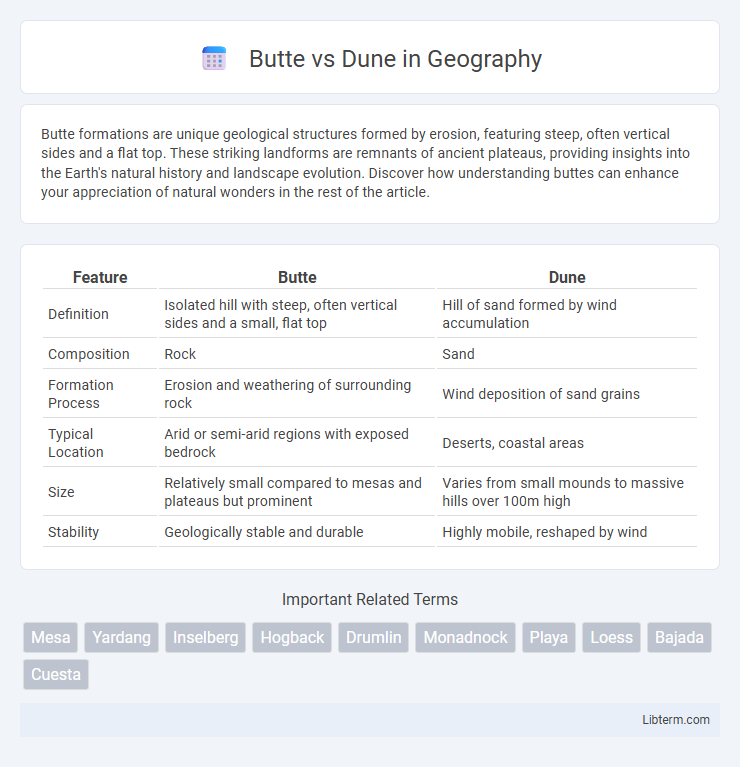Butte formations are unique geological structures formed by erosion, featuring steep, often vertical sides and a flat top. These striking landforms are remnants of ancient plateaus, providing insights into the Earth's natural history and landscape evolution. Discover how understanding buttes can enhance your appreciation of natural wonders in the rest of the article.
Table of Comparison
| Feature | Butte | Dune |
|---|---|---|
| Definition | Isolated hill with steep, often vertical sides and a small, flat top | Hill of sand formed by wind accumulation |
| Composition | Rock | Sand |
| Formation Process | Erosion and weathering of surrounding rock | Wind deposition of sand grains |
| Typical Location | Arid or semi-arid regions with exposed bedrock | Deserts, coastal areas |
| Size | Relatively small compared to mesas and plateaus but prominent | Varies from small mounds to massive hills over 100m high |
| Stability | Geologically stable and durable | Highly mobile, reshaped by wind |
Introduction to Buttes and Dunes
Buttes are isolated hills with steep, often vertical sides and a small, flat top, formed primarily through erosion processes that strip away softer surrounding material. Dunes consist of large, mounded accumulations of sand shaped by wind action, typically found in arid desert regions or along coastal shorelines. Both landforms represent unique geological structures but differ significantly in composition, formation, and environmental context.
Geological Formation of Buttes
Buttes are isolated hills with steep, often vertical sides and a flat top, formed through differential erosion where harder rock layers resist weathering while softer layers erode away. This geological formation typically occurs in arid or semi-arid regions where sedimentary rock layers have been uplifted and subsequently worn down by wind and water erosion. Unlike dunes, which are composed of loose sand accumulated by wind, buttes are solid rock formations representing the remnants of ancient plateaus or mesas.
Geological Formation of Dunes
Dunes are formed through the accumulation and movement of sand grains shaped by wind processes, primarily in arid and coastal environments. Their geological formation involves aeolian transport, where wind erodes, transports, and deposits sand, creating distinct ridge-like structures stabilized by vegetation or moisture. Unlike buttes, which are isolated rock formations resulting from erosion of sedimentary layers, dunes are dynamic landforms continuously reshaped by wind activity.
Key Differences Between Buttes and Dunes
Buttes and dunes differ primarily in their composition and formation processes, with buttes being steep, isolated rock formations shaped by erosion, while dunes consist of loose sand grains molded by wind activity. Buttes typically feature a flat top and are remnants of plateau erosion, often found in arid regions with exposed bedrock, whereas dunes constantly shift and reform due to prevailing wind patterns in desert or coastal environments. The stability and permanence of buttes contrast with the dynamic, migratory nature of sand dunes, highlighting their distinct geological characteristics.
Physical Characteristics of Buttes
Buttes are isolated hills with steep, often vertical sides and a flat top, formed through extensive erosion of sedimentary rock layers. Typically smaller than mesas and plateaus, buttes exhibit a distinctively narrow profile due to differential weathering that leaves resistant rock capping softer layers. In contrast to dunes, buttes are composed of solid rock rather than loose sand, making them more stable landforms with rugged, cliff-like faces.
Physical Characteristics of Dunes
Dunes are dynamic landforms composed of loose sand shaped by wind, characterized by their smooth, undulating ridges and sharp crests, often reaching heights of several meters. Unlike buttes, which are isolated, steep-sided rock formations, dunes exhibit fluid, ever-changing shapes due to continuous wind erosion and deposition. The texture of dunes is granular and fine, contrasting with the hard, resistant surfaces of buttes, reflecting their distinct geological compositions and formation processes.
Environmental Conditions for Buttes
Buttes form in arid or semi-arid environments characterized by minimal vegetation, sparse rainfall, and intense temperature fluctuations that accelerate rock weathering and erosion. These isolated landforms are typically found in deserts or plateaus where wind and water erosion selectively wear away softer sedimentary rock layers, leaving behind steep-sided, flat-topped hills. The dry climate and limited soil cover contribute to the preservation of buttes by reducing the rate of biological weathering.
Environmental Conditions for Dunes
Dunes form in arid or semi-arid regions where abundant loose sand is available and consistent wind patterns facilitate sand movement and accumulation. Environmental conditions for dunes include low vegetation cover, minimal moisture, and prevailing wind velocities typically between 15 to 60 kilometers per hour, which are sufficient to transport sediment but not so strong as to erode established dune structures. These conditions contrast with buttes, which develop in more stable environments featuring rock formations and less dynamic sediment transport.
Ecological Significance: Buttes vs Dunes
Buttes serve as isolated ecological refuges, supporting unique flora and fauna due to their steep, rocky environments and limited soil accumulation. Dunes exhibit dynamic ecosystems characterized by specialized plant species adapted to shifting sands and salt tolerance in coastal environments. Both landforms contribute to biodiversity by offering distinct habitats that sustain endemic and resilient species.
Famous Examples Around the World
Iconic buttes such as Monument Valley in the United States showcase towering sandstone formations shaped by erosion, standing as geological monuments with steep, vertical sides. Famous dunes like the Sahara Desert's Erg Chebbi in Morocco highlight vast, wind-sculpted sand landscapes that shift and reshape, creating dynamic natural art. Both buttes and dunes serve as distinctive landmarks, illustrating the diverse processes of wind and water erosion shaping Earth's surface globally.
Butte Infographic

 libterm.com
libterm.com